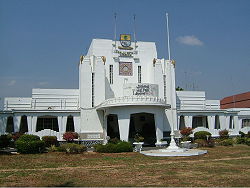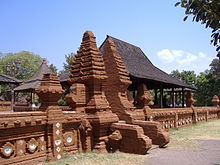- Cirebon
-
Cirebon City Hall, Cirebon, West Java, Indonesia 
SealNickname(s): Kota Udang (City of Shrimps), Kota Wali (City of Wali) Motto: "Gemah Ripah Loh Jinawi" Location of Cirebon in Indonesia Coordinates: 6°43′S 108°34′E / 6.717°S 108.567°E Country Indonesia Province West Java Government - Mayor Subardi S.Pd Area - Total 37.54 km2 (14.5 sq mi) Population (2010 Census) - Total 298,224 - Density 7,944.2/km2 (20,575.3/sq mi) Time zone WIB (UTC+7) Cirebon (formerly referred to as Cheribon in English) is a port city on the north coast of the Indonesian island of Java. It is located in the province of West Java near the provincial border with Central Java, approximately 297 km east of Jakarta, at 6°43′S 108°34′E / 6.717°S 108.567°E.
The seat of a former Sultanate, the city's West and Central Java border location have seen its history influenced by both Sundanese and Javanese culture and also Chinese.[1]
Contents
Etymology
Being on the border of "Sunda" (ie, West Java) and "Jawa" (ie, Central Java), many of Cirebon's residents speak a dialect that is a mix of Sundanese and Javanese, and it is thought that the word "cirebon" derives from the Javanese word, caruban, meaning "mixed", a reference to the city's mix of Sundanese, Javanese, Chinese, and Arabic cultural elements. Alternatively, it could be derived from the Sundanese words of "Ci" (water or river) and "Rebon" ("shrimp").[1] (Indeed the main production of the city is fishery including shrimps.
Aside from fishery, its harbour, Tanjung Emas, on the Java Sea has been a major hub for timber from Borneo. A small landing site "Penggung" also serves the TNI-AU. The city lies on Jalur Pantura (Pantai Utara Jawa), a major road on the northern coast of Java that stretches from Anyer, passes through Jakarta, and ends at Surabaya.
History
According to the manuscript Purwaka Caruban Nagari, in 15th century Cirebon started as a small fishing village named Muara Jati. At that time the port of Muara Jati already attracted foreign traders. The port master at that time is Ki Gedeng Alang-Alang appointed by the king of Galuh kingdom located inland in Kawali, Ciamis. Ki Gedeng Alang-Alang moved the port to Lemahwungkuk, 5 kilometres southward. As the new settlement leader, Ki Gedeng Alang-Alang was bestowed the title "Kuwu Cerbon" (Cerbon village leader).
A prince from Pajajaran, Prince Walangsungsang, convert to Islam, and was appointed as Adipati of Cirebon with the title Cakrabumi. He established the new kingdom of Cirebon and declared independence from Galuh. The establishment of Cirebon sultanate marked the first Islamic rule in Western Java, that grew from modest fishing village of Muara Jati to a busy port of Java northern coast.[2] Cirebon grew as one of the independent sultanates under the leadership of Sunan Gunungjati, in the early 16th century.
The kingdoms of Banten and Mataram fought over Cirebon, which declared its allegiance to Sultan Agung of Mataram. But the later Mataram king ceded the city to the Dutch in the 1677.[1] A treaty in 1705 saw Cirebon become a Dutch protectorate jointly administered by three sultans whose courts rivalled those of Central Java.[1]
During the time of the Dutch "Culture System" a flourishing trade in colonial cash crops attracted many Chinese entrepreneurs and the Chinese influence is still evident in the batik for which Cirebon is famous[citation needed].[1] Cirebon suffered a famine in 1844, apparently triggered by a combination of drought and the shift from subsistence agriculture to cash crops, particularly indigo and sugarcane.[citation needed]
Demographics and culture
The city's population was 298,224 at the Indonesia Census of 2010.[3] As with other coastal cities in Indonesia, a large population of ethnic Chinese has flocked into the city as a result of long-term Chinese immigration since the seventeenth century.
Cirebon itself is known as Grage in the Cirebon dialect of Javanese language, which came from the words "Negara Gede", meaning "Great Kingdom."
Although surrounded by Sundanese-speaking areas in West Java, linguists have stated clearly that Cirebon (and the historically related region of Serang city in Banten Province) are Javanese language areas. In addition, this is supported by the Cirebon people referring to themselves as "wong Jawa" ("Javanese people"), and to their language as "basa Jawa" ("Javanese"). However, the Cirebon dialect is sufficiently different from the dominant south central Javanese dialect that it is sometimes assumed to be non-Javanese by outsiders. See also: Java, languages map.
Batik textiles from Cirebon are particularly renowned. The Tari Topeng Cirebon, or Cirebon mask dance, is a dance style peculiar to the city. Tarling is a musical tradition reminiscent of Bandung's kecapi suling music with except that it features guitar, suling (bamboo flute) and voice.[1]
As a coastal city, Cirebon's main industry is fishery. Its products include terasi (shrimp paste), shrimp crackers and salted fish. Cirebon is known for local foods, such as nasi lengko (rice mixed with bean sprouts, fried tofu, fried tempeh, topped with peanut sauce and soy sauce), nasi jamblang (rice of various side dishes), empal gentong ( a kind of curry ), tahu gejrot (fried tofu topped with thin and sweet soy sauce), tahu tek-tek (fried tofu topped with peanut sauce and mixed with vegetables) and ayam panggang (barbecue chicken). Another native food is "Docang" (lontong with sour vegetable soup).
Administration
Cirebon is divided into five subdistricts: Harjamukti, Kejaksan, Kesambi, Lemahwungkuk, and Pekalipan.
Economy
Cirebon City economy is influenced by the strategic geographical location and characteristics of natural resources so that the structure of its economy dominated by manufacturing, trade, hotels and restaurants, transport and communications and service sectors. Tomé Pires in the Suma Oriental around the year 1513 mentions Cirebon is one of the trade center on the island of Java. After Cirebon taken over by the Dutch East Indies government, in 1859, designated as a transit port of Cirebon import-export goods and the political control center for the region in the interior of Java.
Until 2001, the economic contribution to the City of Cirebon is a processing industry (41.32%), followed by trade, hotels and restaurants (29.8%), transport and communications sector (13.56%), services sector (6.06%). While other sectors (9.26%) including mining, agriculture, construction, electricity, gas and an average of 2-3%.
public service
Nearly 93% of the population has been underserved by service water from PDAM Cirebon, the majority of customers in the city's water supply to households (90.37% or as many as 59,006) of the total number of existing connections (65,287).[4]
health
Since the Dutch East Indies government, Cirebon City has had a hospital named Orange, which unveiled its use on August 31, 1921 and commenced operations from September 1, 1921.
In 2009 in the city of Cirebon has been available about 6 general hospitals, four maternity hospitals, 21 health centers, 15 health centers Maid, 20 Mobile Health Center, and 81 Pharmacies and Drug Stores 31. With the number of medical personnel such as specialist doctors about 94 people, and 116 general practitioners, 37 dentists, 847 nurses and 278 midwives.[5]
Orientation and places
The main boulevard is Jalan Siliwangi and it runs from the train station to the canal via the Pasar Pagi ("Morning Market"), and then the street becomes Jalan Karanggetas along which are most of Cirebon's banks, restaurants, and hotels.
Wali Songo, especially Sunan Gunung Jati, is known to have influenced the city's history. Sunan Gunung Jati's grave is located several kilometres outside the city, in a district called Gunung Jati. There are two temples and a cave system built by two Chinese architects around the 1880s, decorated by Chinese and Western porcelain. The village of Trusmi, about five kilometers outside of Cirebon, has been noted for batik production. Plangon is a habitat of monkeys.
Palaces
Cirebon has four palaces - known as Kratons -
- Kraton Kasepuhan
- Kraton Kanoman
- Kraton Kacirebonan
- Kraton Keprabonan
Port of Cirebon
The Port of Cirebon was established by the Dutch East India Company in 1865, principally as an export point for spices, sugar cane and raw materials from West Java. Warehouses and open storage areas were developed by 1890, and a British American Tobacco cigarette factory was built in the early twentieth century.[citation needed]
Port activity is dominated by bulk imports of coal, liquid asphalt and vegetable oils for the West Java hinterland. Until 2002, the port also catered for minor container trade and cruise shipping. In 2006 the port handled 3.27 million metric tons (MT) of trade, more than 90 percent as imports from other Indonesian ports.
References
- ^ a b c d e f Turner, Peter (November 1995). Java. Melbourne: Lonely Planet. pp. 229. ISBN 0-86442-314-4.
- ^ www.cirebonkota.go.id Profil Sejarah Pemerintahan
- ^ http://www.tempointeraktif.com/hg/bandung/2010/09/01/brk,20100901-275625,id.html
- ^ ciptakarya.pu.go.id Profile Cirebon
- ^ Cirebon health data
Further reading
- Graaf, H. J. de (Hermanus Johannes), 1899-(?), "Chinese Muslims in Java in the 15th and 16th centuries : the Malay Annals of Semarang and Cerbon / translated and provided with comments by H.J. de Graaf and Th.G.Th. Pigeaud ; edited by M.C. Ricklefs. Publisher: [Melbourne] : Monash University, 1984. Description: xiii, 221 p. : folded map ; 21 cm. ISBN 0-86746-419-4 : Series: Monash papers on Southeast Asia ; no. 12
Coordinates: 6°43′S 108°34′E / 6.717°S 108.567°E
Regencies and cities of West Java (Jawa Barat) Capital: Bandung Regencies

Cities (Kota)
See also: List of regencies and cities of Indonesia Categories:- Populated places in West Java
- Port cities and towns in Indonesia
- Cirebon
- Cities in Indonesia
- Regency capitals of Indonesia
Wikimedia Foundation. 2010.




